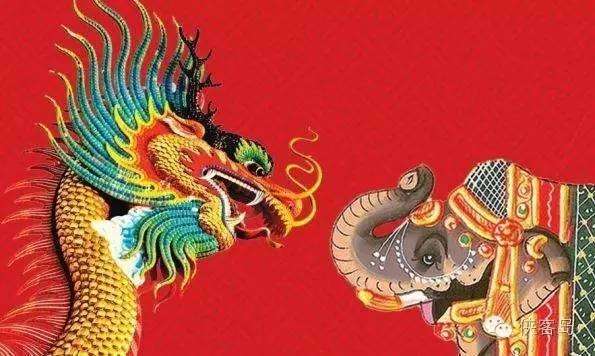The Belt and Road & Sino-Indian Relation

By Yang Fanxin
As one of the most important bilateral relations in the world, Sino-Indian relation is often described as "the Dragon and the Elephant" by the media; especially after "the Belt and Road" is proposed, Sino-Indian relation seems mystified. The rendering by media results in Indian government's irresolution to develop relation with China.
"The Belt and Road" initiative was raised by Chinese President Xi Jinping in September and October 2013 in Kazakhstan and Indonesia successively; it is the general term of "Silk Road Economic Belt" and "21st-Century Maritime Silk Road". Many countries responded actively except India that is situated along "The Belt and Road". Some scholars pointed out that India aimed to become the largest country in the world and took China as the competitor, it worried about the possible economic impact from China. In fact, "the Belt and Road" initiative has countless ties with India of long standing, which will certainly promote the economic & trade and cultural exchanges of China and India.
Historical relation of "the Belt and Road" & Sino-India
The Silk Road traditionally advances the business, culture and idea exchange of China and South Asian countries. It is a business route built by business troupes with constant efforts in spite of the tough natural environment. The Silk Road in a broader sense refers to each and every cultural exchange and business route formed since the medieval times crossing the Eurasia and even North Africa and some parts of East Africa. It also covers the Maritime Silk Road and the Northwest Silk Road playing vital roles in Song Dynasty as well as the South Silk Road, which worked as land transport routes during the early Song Dynasty in replace of the Northwest Silk Road. The west section stretched from west of Congling to Europe. South route of the west section started from Kashmir in Pamir Mountain to Pakistan and India, or led to Europe by way of Peshawar, Kabul, Meshed, Baghdad and Damascus. According to Zhang Qian's record and other historical materials, on the south route of Silk Road, the Sino-Indian trade presented prosperous; China's raw silk, silk thread and silk were transported to Indian port - Barygaza commercial center and then sold to other Indian areas.
Currently, the "Silk Road Economic Belt" covers six economic corridors including BCIM Economic Corridor, which draws an economic & trade and transportation network connecting Europe, Asia and Africa; three-dimensional transport network of railway, highway and sea & air lines, transmission network, communication network and oil & gas pipeline networks together form an integrated infrastructure interconnection network, acting as the physical bases of "six economic corridors". BCIM Economic Corridor radiates the economic effect of Eurasian Economic Corridor to South Asia, South East Asia and the Indian Ocean region, with vast development potential.
The traditional Maritime Silk Road advances the unprecedented prosperity of Indian port cities. The war-stricken natural environment and the endangered security along the Silk Road due to instability among the Eurasian areas undermined the dominant status of the traditional Land Silk Road, and the Maritime Silk Road, instead, took its place. The Maritime Silk Road was the major artery of the global marine traffic in ancient times. During the Western and Eastern Han Dynasties, a sail from Guangzhou of China could lead to India, Persia in the west and the Southeast Asian countries in the south. The Tang Dynasty witnessed both the heyday of the Land Silk Road and the fast development of marine traffic. More ship routes were developed and access to Persian Gulf coast via the South China Sea and the Indian Ocean was available. Overseas immigrants emerged also. The Maritime Silk Road stepped into flourish during the Song and Mongol Yuan Dynasties and ship routes could be classified as those along the East China Sea and those along the South China Sea. The South China Sea routes set out from coastal ports like Guangzhou of Guangdong Province or Quanzhou of Fujian Province and sailed on to the South China Sea, the Southeast Asia, the Indian Ocean, the Arabian Sea and then the coastal areas along the Persian Gulf, linking up areas across the West Asia and Central Asia.
On this route, Calicut, the third largest city of Kerala in South India achieved unprecedented prosperity as an important port of Maritime Silk Road. Calicut was referred to as Guli in ancient Chinese books. As early as the early Ming Dynasty, the Ming regime established relationships with the coastal cities of India Peninsula. In 1403, Zhu Di, the Emperor Cheng of Ming Dynasty dispatched Yin Qing as envoy to visit Kezhi (Cochin) and Guli (Calicut) and summon them to the His Majesty's court. The two countries sent envoys to pay a return visit with Yin Qing and took with them the peppers and pearls from the two countries as gifts. The fleet of Zheng He once stopped in the Port of Calicut for resupply of fresh water and food and considered it as the backup warehouse for the fleet's trip into the Arabian Sea and African coast. Based on the estimates of Madison, the British statistician, "during Zheng He's voyage, the trade volume between China and India accounted for more than half of the global gross output", and the flourishing trade was a great success lasting for over 2 decades.
There are two major routes of the 21st-Century Maritime Silk Road, one running from coastal ports of China to the Indian Ocean via South China Sea; the other running to the South Pacific via South China Sea, acting as the maritime traffic line linking the east to the west and an important passage for exchange of mankind's physical and immaterial civilization. The implementation of the Maritime Silk Road would involve China's neighbor the Southeast Asia and even vaster areas of the Indian Ocean including dozens of land and maritime neighboring countries. It's indicated in the Vision and Proposed Actions Outlined on Jointly Building Silk Road Economic Belt and 21st-Century Maritime Silk Road (hereinafter referred to as Vision and Proposed Actions) that, the Initiative will focus on jointly building smooth, secure and efficient transport routes connecting major sea ports along the Belt and Road to promote the trade.
"The Belt and Road" initiative to advance mutual benefit of China and India
At present, there are few interactions between China and India in the framework of "the Belt and Road"; while with the overwhelming trend of global economy development to Asian areas, co-building of "the Belt and Road" will be an inevitable topic for Sino-Indian relation and regional interaction.
Firstly, China and India have conjunction points in infrastructure construction. As the second largest economic entity in the world, China has led the infrastructure construction. In the past 20 years, China has raised lots of important ideas on infrastructure construction and achieved success, such as establishing Asian Infrastructure Investment Bank, which is a great example of Sino-Indian cooperation. Meanwhile, India has grand design in Infrastructure. Since Modi government took office in May 2014, a series of measures about economic revitalization and government reform have been introduced, which mainly include "Make in India", "Start-up India", "Smart City" strategy and tax system reform, etc. The total budget of Modi government in the new fiscal year 2017 shows that investment to rural areas, infrastructure and poverty elimination will be expanded. Indian government will increase investment in rural areas and agricultural development; 1 trillion rupees (about 14.8 billion dollars) will be invested in rural areas in the new fiscal year, with the agricultural insurance coverage rate up to 40% from 30%.The budget will also stimulate the expense of rural areas; with out of poverty as the main objective, the expenditure of the next fiscal year increases 24%; the income of rural areas is to be doubled in the future 5 years. For the aged railway system, Indian government plans to allocate 100 billion rupees (about 1.48 billion dollars) in the new fiscal year to improve the train safety. In 2017-2018 fiscal year, the new traffic mileage of Indian railway is planned to reach 3500 kilometers. India also prepares a budget of 640 billion rupees to build its highway. Before 2019, Indian government plans to build 10 million houses for those without houses or living in Kutcha house made of mud, straw and leaves. Based on China's success experience in infrastructure construction, there is extensive cooperation room in this field between China and India.
Secondly, broad space exists in economic and trade cooperation of China and India; Alibaba Group invested in Indian e-commerce Snapdeal, Ant Financial Services Group bought into the largest online payment tool Paytm, Chint Group established deep cooperation relations and new energy network system with famous Indian enterprises such as TATA and POWER. According to data of Department of Commerce of Zhejiang Province, Zhejiang Province, alone has invested up to 22 large projects in India in recent 3 years, with total investment amount of 109.1106 million dollars, and the investment volume by China reaches 46.1238 million dollars. It can be observed that the economic and trade cooperation between China and India has entered the fast lane. To strengthen the economic cooperation of these two large countries is an inexorable trend. Currently, the key and difficult points of economic and trade cooperation between China and India are how to capture respective advantages and positions in the industry chain. Sino-Indian enterprises are both parts of the global value chain; for example, hardware of Apple computers are produced in China, software compiled in India, while branded and marketed in America. So Sino-Indian enterprises can try strategic cooperation, open up the third-party market jointly and improve the position and interest in global value chain together. In the framework of "the Belt and the Road", China and India can seek for cooperation fields of mutual benefit and double win.
Thirdly, China and India have a consensus in anti-terrorist and piracy combating. In fact, both parties have taken anti-terrorist and piracy combating as important problems that threaten national security. In maritime affairs, they organize joint search and rescue. Although cooperation has never touched the piracy combating on the Indian Ocean, China has dispatched at least 25 navy fleet to Gulf of Aden; it is possible to establish strategic dialogue and cooperation in this field in the future.
As the great blueprint of China to revitalize Silk Road Spirit, "the Belt and the Road" initiative conforms to the trend of peaceful development & win-win cooperation, advances open cooperation & peaceful development; sticking to the principles of joint building through consultation to meet the interests of all, this initiative devotes to promoting joint development and prosperity. China aims to drive peaceful cooperation by carrying forward Silk Road Spirit. On May 14 and 15, 2017, "the Belt and the Road" International Cooperation Summit Forum will be held in Beijing. As major Asian countries, if Sino-Indian leaders can have the opportunity to start cooperation in various fields under "the Belt and the Road" framework, foresight of leaders and mature diplomatic manners of two countries will both be highlighted, which will surely inject strong and positive energy to peaceful development of the region and even the world.
Yang Fanxin, Associate Research Fellow, Chongyang Institute for Financial Studies at Renmin University of China






